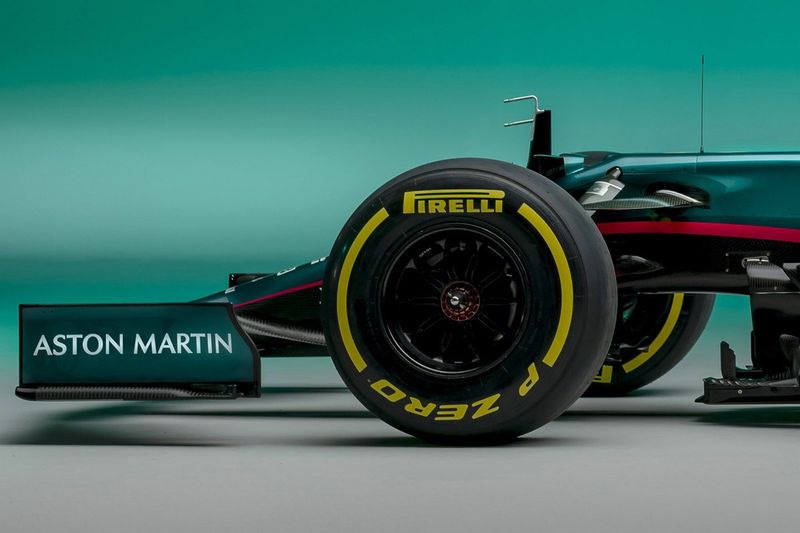The 12 month journey to settle Aston Martin's new F1 livery
When Aston Martin pulled the covers off its striking green AMR21 on Wednesday, it marked the start of an exciting new chapter for the Formula 1 team.
The green and black livery – with those streaks of pink – is certain to stand out when battle commences in Bahrain later this month.
But, equally, the unveiling marked the end of a long journey that Aston Martin has made in coming up with the exact colours that will carry the British sportscar manufacturer’s return to F1.
While it has been known for several months now that Aston Martin wanted to use British racing green for its 2021 challenger, settling down on the specific green was never going to be the work of the moment.
Time and again we have seen teams get their livery colours out of kilter; making them work in real life but being a flop on television or in photographs.
That is why, as Aston Martin’s creative officer Marek Reichman has explained, the final choice on the exact type of green used was something that needed a lot of thought put in to.
“It's been a long journey actually,” explained Reichman, who has designed Aston Martin’s road cars for the past 16 years.
“Colour is something so important. How you perceive colour, how you perceive colour on screen, how you perceive colour in person in sunlight, and also on a grey day at Silverstone, it's a really, really important factor.
“We have spent 12 months developing a colour. We've gone through numerous iterations on the livery – and it went up to the 59th minute of the 11th hour with detail changes to get everything right.
“I think when you see the car, it's spectacular. That's all we can hope for. And it will be the most beautiful colour on the grid.”
The final choice of green appears on the lighter side on the scale of options that Aston Martin could have chosen, but there were a range of factors beyond the actual colour choice itself that needed to be weighed up too.
“I wish it was as easy as looking at Pantone colours and picking the right one,” explained Reichman, who kept in close contact with F1 team boss Otmar Szafnauer as the work progressed.
“Developing the paint colour itself is so complex, because we have to translate that onto our road cars as well. It's not just developing a colour for the livery that sits on the F1 car, because people will say that they want it on their road cars when they see it.
“So you have to go through a full development process, which includes repeatability, damageability, repairability, etc, etc.
“And obviously, in thinking about the F1 car, I've got to consider Otmar's needs for weight. You don't want to be painting a heavy paint. So we've had to look at that as well.
“Plus, how do you get the reflective nature of the beautiful colour with the technology that we know we can paint onto an F1 car, and then put through our spray guns to put it onto a road going car as well.”
Reichman also says that Aston Martin had to go through some pretty extensive testing of the paints in the real world to check that the final colour worked as well on television and in photos as it does when seen in the flesh.
“How we make sure it works in terms of red, green, and blue values on the screen is literally filming the panels and then looking at them through computer screens,” he said.
“You use the right 4K camera technologies, and 3D camera technologies, all of that we have because that's the world we now live in in terms of augmentation, and how you replicate something in the world of design.
“Most of our [car] interiors now are developed in CAD and we don't actually do physical play models. So we have a high capability to simulate both colour, shape and form and ask the computer, is this colour corrected for the eye? And that's how we've done it.
“But it's been a long process, because you have to make sure that when people are passionate about colour, and they happen to come from the world of fashion in some instances and they know their colours, they love what you've done.”
The final judgement on whether the Aston Martin livery is a hit or a miss will be argued out over social media for days to come.
And, while modern F1 liveries are often criticised by fans as not being as good as iconic cars from the past, Reichman says there is only one true judge of what a beautiful F1 car is - but he wants the AMR21 to go beyond that.
“Always as an aesthete, you're looking for things to be more beautiful,” he said. “But I’m going to steal a line from Otmar: fast is beautiful and I absolutely agree.
“So there's always more than one answer to a problem and how you resolve it. Only a few weeks ago, I was looking at the Jordan that came out of the same factory that Otmar is in now and that's a beautiful car.
“I think for sure, you always wish things would be more aesthetically pleasing because I just think people stare when something is beautiful. They stare and they're in awe. And I think that's always a hope.”
Be part of the Autosport community
Join the conversationShare Or Save This Story
Subscribe and access Autosport.com with your ad-blocker.
From Formula 1 to MotoGP we report straight from the paddock because we love our sport, just like you. In order to keep delivering our expert journalism, our website uses advertising. Still, we want to give you the opportunity to enjoy an ad-free and tracker-free website and to continue using your adblocker.




























Top Comments